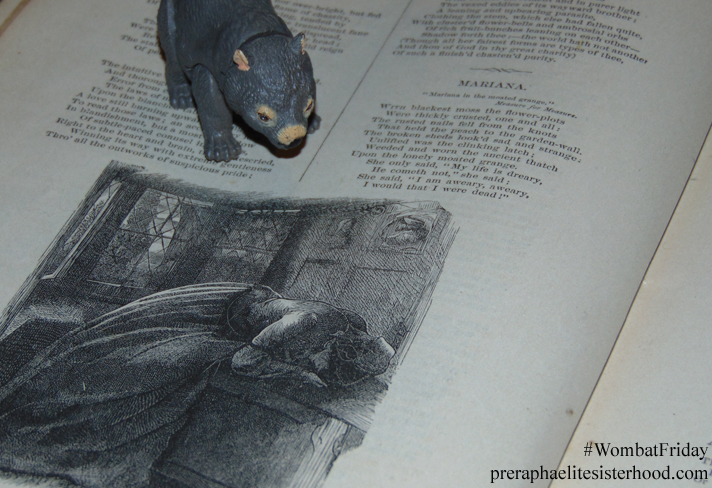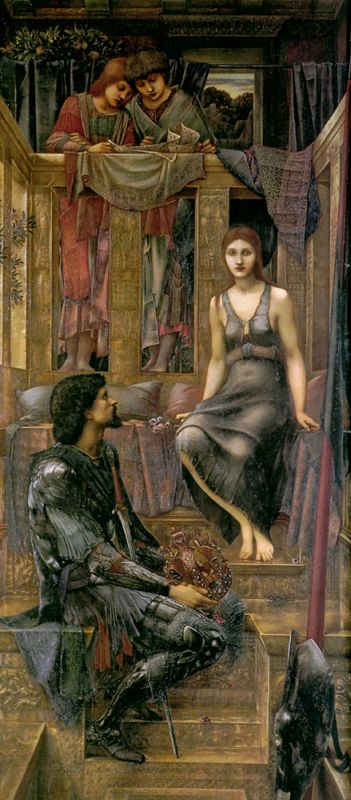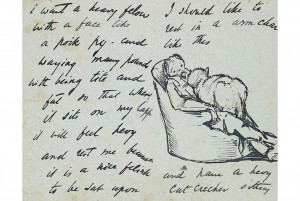Inspired by artist Dante Gabriel Rossetti’s passion for wombats, every Friday is Wombat Friday at Pre-Raphaelite Sisterhood. “The Wombat is a Joy, a Triumph, a Delight, a Madness!” ~ Dante Gabriel Rossetti
The birthday of Alfred,Lord Tennyson was this week, which brings to mind one of my favorite passages from his poem Ulysses:

Elizabeth Siddal’s painting Lady Clare is based on Tennyson’s poem of the same name.

“He does not love me for my birth,
Nor for my lands so broad and fair;
He loves me for my own true worth,
And that is well,” said Lady Clare.
Published in 1842, Lady Clare is a romantic ballad by Alfred, Lord Tennyson. Exploring issues of class, marriage and honesty, Lady Clare is the story of Lady Clare and her betrothed, Lord Roland. When Lady Clare’s nurse confides in her that she is the girl’s true mother, Clare realizes that her life has been a lie and she has no rightful claim on her title or fortune. More important than that, she is no longer of the same class as Roland. Knowing that she risks losing her love, Clare tells her natural mother that she intends to do the honorable thing and tell Lord Roland the truth. Alice, the nurse, begs Clare to keep the truth a secret:
‘I’m a beggar born,’ she said,
‘I will speak out, for I dare not lie.
Pull off, pull off the brooch of gold
And fling the diamond necklace by.’‘Nay now, my child,’ said Alice the nurse,
‘But keep the secret all ye can.’
She said, ‘Not so; but I will know
If there be any faith in man.”
Clare is steadfast and does what she believes to be right. Loving Roland and knowing that she might lose him, she is compelled to tell him the truth. She changes into the gown of a peasant and goes to Roland, accompanied by the white doe he has given her as a gift. Proving that their love is true, Roland still longs to marry her even after he knows the truth of her birth.
Elizabeth Siddal painted Lady Clare in 1857. Using rich, jeweled tones, Siddal shows the nurse/mother clinging to Lady Clare as she begs her to keep her secret. Clare looks away, stoic. Her hand covers Alice’s face as she remains moral and resolute. She must tell the truth. Elizabeth Siddal had her own distinctive style and her work here has a medieval flavor. Interestingly, the stained glass window in the background appears to illustrate the King Solomon story of the two women involved in a dispute over a baby.
More Tennyson posts, courtesy of The Kissed Mouth:
https://youtu.be/QuMwgPGvoOk





Thanks for another fascinating post! I must admit that Ulysses is not my favourite Tennyson poem. But it is interesting how often it crops up in everyday life: Eg it is quoted by Frasier in the final episode of the comedy:
https://www.youtube.com/watch?v=5Dj6cjvPpps
It also appears in the Bond film, Skyfall:
https://www.youtube.com/watch?v=ptqoSZgh7q8&list=RDptqoSZgh7q8#t=57
It also appears at the Athletes village for the London 2012 Olympics:
http://www.theguardian.com/sport/2011/mar/04/tennyson-verse-inspire-olympic-athletes
and (most impressive of all, in my opinion) I noticed that Senator Edward Kennedy quotes from Ulysses at the end of his famous speech from 1980. Interestingly he says that it was a favourite poem of both himself and his brothers Robert and JFK:
https://www.youtube.com/watch?v=p5cKYckTWEM
I loved Judi Dench’s recitation of it in Skyfall. She said is so beautifully, but then I could listen to her read the phone book and probably be moved to tears.
Very true. She is great. The Edward Kennedy speech sends a shiver down my back when I hear it – it was like the pulling down of the curtain on the Kennedy/Liberal era.